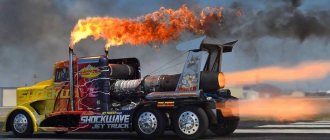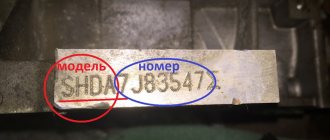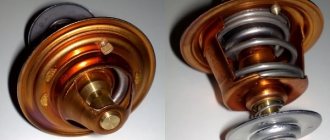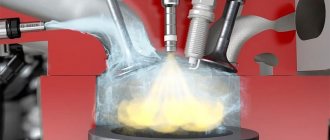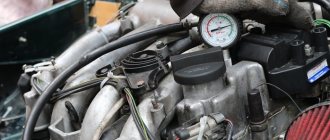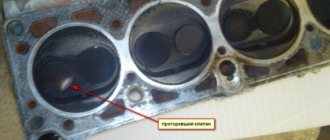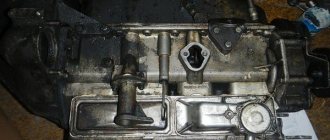Car from A to Z: internal combustion engine design
New section, get ready!
There will be a lot of educational text with pictures. The internal combustion engine (ICE) is the heart of the car. The main feature of these engines is that fuel ignition occurs inside the combustion chamber (CC), and not in third-party external units.
During operation, the thermal energy released as a result of fuel combustion is converted into mechanical energy.
By fuel used
- light liquid (gas, gasoline)
— heavy liquid (diesel fuel)
— Gasoline engines
There are two types: gasoline carburetor and gasoline injection.
In the first case, mixture formation (mixing fuel with air) occurs in the carburetor or in the intake manifold using injectors. Next, the mixture enters the cylinder, is compressed and ignited by a spark from a candle.
In the second case, fuel is injected into the intake manifold or into the cylinder using injectors (atomizing nozzles).
— Diesel engines
Special diesel fuel (DF) is supplied at a certain moment (before reaching dead spots) into the cylinder under high pressure using an injector.
The movement of the piston compresses the mixture even more, the fuel heats up, followed by ignition of the combustible mixture (due to high pressure).
Such engines are characterized by low speed and high torque.
— Gas engines
The engine uses hydrocarbons as fuel. Basically, such engines run on propane, but other gases are also used as fuel.
The main difference from other engines is the high compression ratio. Such engines wear out less due to the fact that the fuel is already supplied in a gaseous state. Also, the efficiency of gas engines is obvious - gas is cheaper than gasoline.
It is also worth noting that it is environmentally friendly - there is no engine smoke.
By ignition method
- from spark (petrol)
- from compression (diesel)
By number and arrangement of cylinders
— In-line engine
The most common arrangement, the cylinders are arranged in a single row perpendicular to the crankshaft. Such engines are simple in design, but with a large number of cylinders, the size of the engine increases in length.
— V-shaped
To reduce the length of the unit, the cylinders are positioned at an angle from 60 to 120 degrees, while the longitudinal axes of the cylinders coincide with the longitudinal axis of the crankshaft.
The engine turns out to be quite small longitudinally (short).
Of the minuses: the engines are quite wide and the block heads are separate, which leads to an increase in manufacturing costs.
— Opposite
The horizontally opposed engine has smaller height dimensions, which will lower the center of gravity of the entire vehicle. The advantages include: compactness, symmetrical layout.
— VR-shaped
Due to the 6 cylinders located at an angle of 150 degrees, a very compact (narrow and short) engine is formed. And also, this engine has only one cylinder head.
— W-shaped
These engines combine two rows of cylinders in a VR design.
The angle of the cylinders is 150 degrees, and the rows themselves are at an angle of 720 degrees.
A standard car engine consists of 2 mechanisms and 5 systems.
The fiery heart of the machine, part 3
Engine. Vibrations and balance. Cylinder configuration. Text: Artem 'S1LvER' Terekhov
Every motorcycle engine has a number of rotating parts. And there are also those that move reciprocatingly (only in a rotary engine there are no such parts). They are basically the “troublemakers,” fervently rocking the motor in different ways.
Let's take a flywheel for example. This big guy spins freely on its bearings and creates no vibrations at all. But in addition to the rotation of the flywheel, the movements of other rotating elements are added: the crank pin, the lower part of the connecting rod, the bearing of the lower head of the connecting rod. And it is this sum (and not individual elements of the overall “rotating picture”) that creates the problem of vibration caused by the imbalance of rotating or centrifugal forces. With the reciprocating movements of parts, everything is also not at all simple: the upper half of the connecting rod and the piston move exactly like this. It is not easy to explain where the vibrations come from in this case, but I will try. As soon as the piston reaches the top of its stroke (top dead center, TDC), it must slow down sharply and stop almost instantly, and then accelerate in the opposite direction. The crazy piston reaches its maximum speed somewhere in the middle of the stroke, after which another sharp deceleration follows, “slowing down” at bottom dead center (BDC), after which acceleration occurs again on the upward stroke. Over and over and over again. Each stop at TDC and BDC causes a pulse of vibration that ripples throughout the engine. The physical forces that cause vibration are called inertial or reciprocating forces, they are zero in the middle of the piston stroke and are maximum at TDC and BDC.
The pistons of the little Ninja 250R flutter at a speed of 15.11 meters per second!
All these problems need to be dealt with somehow, because it is simply impossible to ride a bike that kicks and shakes with the whole body. Problem Solving Eliminating the harmful effects of rotating forces is quite simple: remove some material from the flywheel next to the crank pin, or add the same amount of material opposite it, and the design is balanced again. To compensate for the reciprocating forces, you can continue to increase the mass of the flywheels on the side opposite the crank pin so that the total weight of the reciprocating assemblies is balanced. In this way, imbalance at TDC and BDC of the piston stroke is eliminated. Vibration problem solved! But no. This approach doesn't work between TDC and BDC because the added mass on the flywheels creates a constant torque force while the reciprocating force (yes, those pistons are a problem) varies from maximum to zero and vice versa. The result is horizontal vibration. And although the mass of the rotating parts of the crankshaft is constant (unless it is already falling apart from the vibrations that we, as real engineers, have awarded it with), part of this mass is constantly changing its position, thus changing the torque forces. The process of rotation of the crankshaft and the action of the forces that arise in this case are partially shown in the video about the principle of operation of the cruciform crankshaft of the Yamaha R1 2009, I advise you to watch it for a better understanding of what I wrote here (starting at 2.30 minutes).
The problem of engine balancing is very complex from a mathematical point of view. Current methods represent a compromise compared to the ideal situation. Based on this, it becomes clear why designers tried a huge number of different engine and crankshaft designs: to investigate and try to eliminate their inherent vibration and balance problems. I think you have already guessed that the task becomes more complicated as the engine size increases. On a 50 cc scooter, vibration manifests itself only in a slight tremor on the steering wheel, which is not at all annoying. The vibration problem limits the displacement of single-cylinder engines to 650 cubic centimeters. It’s not for nothing that KTM’s sports single-barrel enduro bikes of this volume are called “thresher” - the vibrations on the handlebars are so strong that you can close your eyes and imagine yourself doing road work with a jackhammer in your hands. More power means an increase in engine speed, so there is a need for more cylinders. Reducing Vibration There are several ways to reduce vibration that save designers the difficult task of eliminating the cause itself. The frame design plays a huge role: well designed, it reduces vibration levels. You can also secure the engine in the frame using rubber bushings, which act as a vibration insulator. The steering wheel grips are made heavier: this leads to a change in the resonant frequency of the steering wheel, which reduces the “shudder”. A similar method is used in the case of rear-view mirrors. An obvious outsider in this matter is the Hyosung GT250R, whose factory mirrors often burst due to ill-conceived design. It is impossible to eliminate the forces that are the source of difficulties. However, it is possible to create forces equal to them, but oppositely directed, to eliminate existing ones. To do this, one or more balance shafts (often called balancer shafts) are used, driven by the crankshaft, which rotate in the opposite direction to it. Counterweights are placed on the shaft, the mass and location of which is carefully calculated. This approach is optimal in cases where power and weight matter less than convenience and comfort, or when other methods have already been used but have not brought the desired effect. As a result, the balance shaft can be found in both superbike engines (for example, the Suzuki GSX-R1000 2009) and in large tourer engines like the BMW R1200RT. In Search of Power - Bore and Stroke The bore to stroke ratio is a major factor in how power is produced from the engine. The design in which the diameter of the piston is equal to its stroke is called “square”. If you increase the stroke and decrease the diameter, the resulting circuit will be called “long stroke”. The reverse actions will lead to the creation of a “short-stroke” circuit.
Two-liter V-twin from Kawasaki VN2000. The piston stroke significantly exceeds the cylinder diameter
The long-stroke engine features a flat torque characteristic over a wide range of engine speeds. The torque is a consequence of the sufficiently large lever arm on which the force from the long connecting rod is applied. This is what allows a long-stroke engine to develop good traction at low crankshaft speeds. A clear example of a long-stroke design is large-volume cruisers with a V-twin engine. Two-liter V-twin from Kawasaki VN2000. The piston stroke significantly exceeds the cylinder diameter
Suzuki_GSX-R_1000 73.4 x 59 mm. Short-travel configuration - ideal for a sportbike
A short-stroke engine can operate at higher speeds than a long-stroke engine of the same displacement. Consequently, over a certain period of time, more working strokes occur (i.e., power increases). The disadvantage is that the crankshaft lever arm is reduced, resulting in a less flat torque curve. Short-stroke engines are more powerful, but in a narrow range of engine speeds. I think there is no need to explain that sportbikes belong specifically to the short-stroke “tribe” of bikes. In fact, many modern motorcycle engines are close to a square design, with slight deviations in one direction or another (depending on the requirements for the use of the motorcycle). Cylinder Configurations With a little bit of the theory behind us, let's look at the different cylinder layouts. Knowing the general principles, we can already draw independent conclusions about the advantages and disadvantages of specific configurations.
- Single cylinder engine. The main advantages of this scheme are simplicity and small dimensions. The “single-barreled gun” is easy to manufacture and repair, and is also lightweight. Mainly used on mopeds, scooters and off-road bikes. A striking example is cross bikes with an engine capacity of 250 and 450 cubic centimeters. From a technical point of view, single-cylinder engines have several disadvantages: - the need for large flywheels to maintain engine rotation until its next power stroke (think a little and you will understand that ignition of the mixture in a 1-cylinder 4T engine occurs once every two revolutions of the crankshaft) ; — in order to avoid excessive “fatness” of the entire structure, the piston is made as light as possible, and this does not have the best effect on durability. Single-barreled rifles have good power and torque characteristics due to the long connecting rod. However, if you turn such an engine too much, the shortcomings will become obvious. Massive flywheels accumulate a lot of inertia, and the large piston stroke combined with the small cylinder diameter means a high level of wear on these components. Another problem is difficulty starting the engine. Cross-country shoes are mostly equipped with a kickstarter only, and each time you start, you need to set the crankshaft to a position where it almost reaches TDC on the compression stroke, and then give it a strong kick to make it rotate. If the crankshaft is installed incorrectly, or the kickstarter is not pressed hard enough, the would-be rider gets a kick in the leg. Ask experienced crossers, or owners of the Soviet rocket IZH Planeta-Sport, and you will hear many colorful stories about how the unlucky “ringleader” was beaten by his motorcycle.
Honda CRF450R 2009, 1 cylinder, 4 stroke. Kick me!
- Two-cylinder in-line engine. It is essentially a single cylinder engine modified to accommodate two cylinders, pistons and connecting rods. In the traditional British design, the pistons move up and down simultaneously, but the cylinders alternate firing at 360-degree intervals (i.e., every revolution of the crankshaft). The “push” of the power stroke, inherent in single-cylinder engines, is smoothed out here due to two smaller impulses, evenly distributed within two crankshaft revolutions. There are also options with flash intervals every 180 and 270 degrees. In the latter case, the engine becomes similar in character to a V-twin.
Triumph Thruxton 2008, 2 cylinders in line, 360 degree alternating flashes
Yamaha TDM900 2008, 2 cylinders in line, alternating flashes at 270 degrees
- Two-cylinder V-engine. According to many, the best motor circuit for a motorcycle. One can argue with this, but the fact that the age of the idea of using a V-twin is comparable to the age of the idea of a motorcycle itself speaks in favor of the statement. Bad ideas don't last that long. From a balancing point of view, the best cylinder angle is 90 degrees. If the progressively moving masses of pistons and connecting rods are completely balanced, then the unbalanced forces of one cylinder are inevitably balanced by opposing forces in the middle of the stroke of the other. Ducati uses a 90-degree engine design on all its motorcycles, only the Italians call this engine L-twin. This is due to the fact that the upper cylinder is located vertically, and the lower one is horizontal. Previously, this was done to better cool both cylinders with a counter flow of air, but with the use of air-oil and liquid cooling, the scheme has become simply the calling card of Ducati - balanced and very successful from an engineering point of view. There are a great many options for the angle of inclination, as well as the location of the cylinders. Almost everyone has a different approach to building a V-twin. The most interesting are the same Ducati, Moto Guzzi with their transverse cylinder arrangement, Harley-Davidson with a unique sound due to the uneven interval between flashes.
Thanks to their impressive appearance, V-twin engines are very popular among customizers around the world.
- Three-cylinder in-line engine. Represents a compromise between the vibration problems of 2-cylinder and the width of 4-cylinder engines. Among modern manufacturers, only the guys from Triumph have remained faithful to this scheme; most of their model range consists of “triples”. In terms of power, the “triple” is an excellent intermediate option between low-speed 2-cylinder and 4-cylinder in-line engines with their prohibitive power.
Triumph Street Triple 2008, three-cylinder engineering harmony
- Four-cylinder in-line engine. The first production swallow was the 1969 Honda CB750 Four. This bike established the basic design of medium and large displacement engines for many years to come. There is nothing new in such a design - car manufacturers have already chosen it for the best combination of compactness and balance. It’s just that in the 60s, Honda had a couple of compact 4-cylinder in-line engines for sports cars lying around in its bins, which were later adapted for motorcycles.
Yamaha YZF-R1 2004, classic inline four
In fact, the “four” is two two-cylinder engines combined with each other with the crankshaft crank pins shifted by 180 degrees. Power strokes occur quite often, one for each half-turn of the crankshaft. Consequently, the need for large flywheels to maintain motion is eliminated. Due to the good balance of the crankshaft and the relatively small diameter of the flywheels, the 4-cylinder engine has a short piston stroke, so it is easy to “spin”. This has received approval from the ranks of adrenaline-laden consumers. Vibration problems, if any, are solved by proper design of the frame, engine mounts and all components surrounding the engine. There are a huge number of examples of the use of inline four, mainly among Japanese manufacturers. Although BMW also uses it in its motorcycles. Moreover, the Bavarians tilt the cylinders forward, which lowers the center of gravity and has a positive effect on the bike’s handling.
BMW K1200R 2008, note the strong forward tilt of the cylinders
- Four-cylinder V-engine. In fact, it is a twin two-cylinder V-shape. Therefore, all the comments relating to the V-twin can be applied in this case. The optimal camber angle is the same 90 degrees. V4s are very expensive to manufacture and difficult to maintain, which has not stopped them from becoming famous thanks to their widespread use in Honda's VFR lineup. The most advanced engine of this design is considered to be installed in the Honda NR750, which was produced in limited quantities. Distinctive features of the NR750 motor are 8 valves per cylinder and oval piston shape. Although the new VFR1200F may well compete for the honorary title of “the most advanced V4”. Another worthy example of the use of the V4 scheme is the Ducati Desmosedici RR.
Engine Honda VFR1200F 2010
- Boxer engine. The two-cylinder boxer engine offers an almost ideal solution to the balancing problem. The simultaneous movement of the pistons in opposite directions compensate each other. The level of vibrations generated is minimal. A motor of this type is widely used by BMW in motorcycles for a wide variety of purposes. The crown of evolution of the Boxer (as the 2-cylinder boxer is sometimes called) was the HP2 Sport model. However, in terms of dynamic performance, the boxer is too far from its 4-cylinder in-line competitors.
BMW HP2 Sport 2008, the pinnacle of boxer evolution
By analogy with in-line engines, the two-cylinder boxer engine turned into a four-cylinder engine in the same way. The only motorcycle that uses such an engine is the Honda Gold Wing with an engine capacity of 1000, 1100 and 1200 cc. cm (as the model evolves). No vibrations, excellent handling due to the low center of gravity - the trump cards are the same as in the case of its 2-cylinder brother. The newest version of the Gold Wing is equipped with a six-cylinder boxer engine with a capacity of 1800 cc. cm is the only representative of this arrangement among production motorcycles (just as its 4-cylinder predecessor was the only one in its time). For all its advantages, a boxer engine with any number of cylinders has one very serious drawback. And this disadvantage is excessive width, which is a constant problem for motorcycle designers and limits the range of application of this design to cruisers and tourists. The BMW HP2 Sport most clearly demonstrated just how big the Boxer's dimensional shortcomings are.
*****
We have looked at all the engine diagrams that are used on modern production motorcycles. Left behind were such exotics as in-line six-cylinder engines and V-type engines with an odd number of cylinders. Motorcycles using such motor designs have long become collectible curiosities (and some were originally sports prototypes, the engines of which can only be accessed by racing mechanics and engineers), and therefore are of purely academic interest to us. If you want something transcendental, type “y2k” in the YouTube search. I think the result will surprise you...
Systems
- cooling
- lubricant
- nutrition
- ignition
- exhaust gas release
Let's take a closer look at the engine mechanisms.
crank mechanism
This mechanism is designed to convert the reciprocating motion of the piston in the cylinder into the rotational motion of the engine crankshaft.
In turn, the crank mechanism consists of:
1) cylinder block with crankcase;
2) cylinder heads;
3) engine oil pan;
6) crankshaft;
How to determine the piston stroke?
Two-stroke engines, as a rule, are installed on cheaper, simpler motorcycles, which are basically what all beginners ride. The scope of application of four-stroke engines is more serious machines that require some operating experience.
The reasons for this division of “spheres of influence” will become clear if we consider how, in principle, some engines differ from others.
The main arguments of two-stroke engines are simplicity of design and low cost of production. After all, all operations of the working cycle are carried out by the same element - the piston. During its movement, it opens the inlet window, through which the working mixture is sucked into the crank chamber; pre-compresses it in this chamber to 1.25-1.5 kg/cm2; opens bypass channels through which the working mixture enters the space above the piston; compresses it again and, already moving down, opens the exhaust window to allow exhaust gases to escape. Its skirt has special cutouts, or windows, corresponding in configuration to the windows in the cylinder. Pins are installed in the grooves for the piston rings, protecting the rings from turning, the joints getting into the windows and, consequently, from breakage.
As you can see, the intake and exhaust process is structurally solved and is not subject to adjustment. This, of course, makes operating the motorcycle much easier.
The four-stroke engine is another matter. In it, intake and exhaust are carried out by independent valves driven through levers or pushers from the cam (camshaft) shaft. This shaft, in turn, is connected to the engine crankshaft and must ensure the opening and closing of the valves at moments when the piston is in a strictly defined position. This whole mechanism is called gas distribution. During operation, its parts gradually wear out, and over time it is necessary to make adjustments. This operation, of course, is not on a par with surgical ones, but it still requires skill. Inept adjustment will immediately have an impact - the engine will lose power, “knock”, or even fail altogether. From what has been said, it seems that we can conclude that a two-stroke engine is a motorcyclist’s dream. But let's look at the matter from the other side. Go back to that phrase where we define two- and four-stroke engines. Did you find her? Please note: according to this definition, it turns out that two-stroke engines with the same dimensions as four-stroke engines should be twice as powerful! But in practice this is far from the case! What's the matter?
The reason for this apparent paradox is the very simplicity of the device, which was so captivating when we first met it. The piston performs too many functions. He is not able to “plug all the holes.” Despite various tricks that improve purging (special direction of bypass channels, special protrusions on the piston head, etc.), the cylinders of two-stroke engines are still poorly cleaned of combustion products. As a result, they receive relatively less fresh mixture, the combustion process proceeds worse, and, therefore, the power inevitably drops. At the same time, when exhaust gases are released, a large amount of fresh mixture “flies into the chimney” along with them - a so-called “direct emission” occurs. It alone increases fuel consumption by 20-30%. And besides this, there is also a reverse emission - into the carburetor. On older types of motorcycles with an open mesh air filter, losses from the return emission reached 20-25%.
But a two-stroke engine is not only much more power-hungry than a four-stroke engine. For reasons* just discussed, it also pollutes the air noticeably more. This last argument was taken seriously by few people just a dozen years ago. And now it is becoming one of the main ones and, presumably, over time it can significantly affect the share of certain engines in the total output.
And yet, be that as it may, the simplicity of the device remains one of the most desirable qualities of a motorcycle in general and an engine in particular, because it is the key to reliability. If from this position we consider, for example, the question of how many cylinders an engine should have, then we can see interesting patterns, and sometimes contradictions.
Source
Cylinder block
It is a one-piece cast part that connects the engine cylinders. There are supporting surfaces on it for installing the crankshaft, and the cylinder head is usually attached to the upper part.
The cylinders in the block are either cast integrally with the block, or are separate replaceable bushings.
Also, the block performs another, no less important, function - oil is supplied under pressure through the holes in the block for lubrication.
The inner walls of the cylinders serve as guides for the pistons as they move.
Piston types
In internal combustion engines, two types of pistons are used, differing in design - solid and composite.
Solid parts are manufactured by casting followed by machining. The metal casting process creates a blank that is given the overall shape of the part. Next, on metalworking machines, the working surfaces in the resulting workpiece are processed, grooves are cut for rings, technological holes and recesses are made.
In the component parts, the head and skirt are separated, and they are assembled into a single structure during installation on the engine. Moreover, assembly into one part is carried out by connecting the piston to the connecting rod. For this purpose, in addition to the finger holes in the skirt, there are special eyes on the head.
The advantage of composite pistons is the ability to combine manufacturing materials, which improves the performance of the part.
Gas distribution mechanism
- intake and exhaust valves.
Camshaft
As a rule (in modern cars) it is located in the upper part of the cylinder head.
An integral part of the camshaft are its cams. There are exactly as many of them as there are intake and exhaust valves. These cams, pressing on the valve pusher lever, open it, and “running away” from the lever, the valve closes under the action of the return spring.
valves
The valve consists of a flat cap (head) and a stem. Moreover, the diameter of the intake valve head is made slightly larger than the diameter of the exhaust valve head (this is done for better filling of the cylinders with fuel).
Operating principle and main characteristics
The operating cycle of an internal combustion engine (ICE) consists of a series of processes that increase the power of the engine acting on the crankshaft. The work cycle consists of several stages:
- the cylinder is filled with the fuel mixture;
- the mixture is compressed;
- the fuel mixture ignites;
- the gases expand and the cylinder is cleaned.
In an internal combustion engine, the piston moves in one direction (up or down). The crankshaft makes one revolution in two strokes. The working stroke of the piston is the one during which useful work is performed and the burnt gases expand.
Two-stroke engines are those in which the cycle is completed in one revolution of the crankshaft or in two strokes. Four-stroke units are characterized by completing a working cycle in two revolutions of the crankshaft or in four strokes .
Main characteristic indicators of a 4-stroke engine:
- Due to the movement of the working piston, gases are exchanged.
- The unit is equipped with a gas distribution mechanism that allows the cylinder cavity to be switched to inlet and outlet.
- An exchange of gases occurs at the moment of a separate half-turn of the crankshaft.
- Gear reducers and a belt chain drive make it possible to change the timing of gasoline injection, ignition and gas distribution mechanism drive in relation to the crankshaft speed.
Engine operating principle
Definitions
Top dead center
– the uppermost position of the piston in the cylinder.
Bottom dead center
– the lowest position of the piston in the cylinder.
Piston stroke
- the distance that the piston travels from one dead center to another.
The combustion chamber
– the space between the cylinder head and the piston when it is at top dead center.
Cylinder displacement
- the space released by the piston when it moves from top dead center to bottom dead center.
Engine displacement
– the sum of the working volumes of all engine cylinders. Expressed in liters, it is therefore often called engine displacement.
Total cylinder volume
– the sum of the volume of the combustion chamber and the working volume of the cylinder.
Compression ratio
– shows how many times the total volume of the cylinder is greater than the volume of the combustion chamber.
Compression
– pressure in the cylinder at the end of the compression stroke.
Tact
– a process (part of the working cycle) that occurs in the cylinder during one stroke of the piston.
Source
How to measure the piston stroke of a moped
How to measure crankshaft stroke.
If you haven't heard the word crankshaft, you don't need this article. If you understand that someday you will have to repair the engine rather than change the motorcycle, what is written here may come in handy. If you are going to buy spare parts in Kharkov or Odessa, be sure to read!
Theory. The crankshaft is a part that converts translational movements into rotation. For example, take a thread, tie a nut, and twist it. Or watch an old movie with a steam locomotive and how the wheels are turning. The explosion of gasoline vapor pushes the piston, which moves progressively, and through a pin it is connected to the crankshaft connecting rod, which begins to rotate. I know you do, read on. So these movements differ in stroke length. (the length of the thread with the nut). After all, engine volume depends on the diameter of the piston and the stroke of this piston connected to the connecting rod. Therefore, engines with the same displacement can have different crankshafts, and engines with the same crankshaft can have different displacements. In practice, this is the possibility of boosting the engines, replacing one crankshaft with another, increasing the engine volume, and, accordingly, the power. This is done quite often on Chinese engines, and the Japanese also do this.
Practice. Measuring the stroke of a crankshaft connecting rod is a little more difficult than measuring the stroke of a piston. I applied a ruler to the piston, and I already have the size. To measure the stroke of the crankshaft connecting rod, we need to make two measurements, and then use a calculator to get the result (subtract one measurement result from the other). We move the crankshaft to top dead center. (The connecting rod is as far away from the cheeks as possible). First you need to measure the distance from the top point on the connecting rod under the finger to the nearest point on the crankshaft cheek, as in the first photo. We write the result into the calculator. We move the crankshaft to bottom dead center. Photo 2. (The connecting rod is as close to the cheeks as possible). For maximum accuracy, insert the piston pin, I don’t have one on hand, so you can measure it this way. We now measure the distance between the same points that we measured in the previous alignment, that is, between the top point on the connecting rod under the finger to the nearest point on the crankshaft cheek. We subtract the resulting second measurement result using a calculator and obtain the crankshaft stroke. The more accurate the measurements, the more accurate the result. Knowing all this, now you are not afraid of any dishonest seller, even if this knowledge is not useful, you are still more experienced now!
Source
Concepts and definitions adopted for piston engines
The basic definitions adopted for piston engines are shown below using a single-cylinder engine diagram.
Top dead center (TDC) is the position of the piston in the cylinder at which the distance from it to the axis of the engine crankshaft is greatest.
Bottom dead center (BDC) is the position of the piston in the cylinder at which the distance from it to the axis of the engine crankshaft is the smallest.
Piston stroke S (m) is the distance along the cylinder axis between dead points. With each stroke of the piston, the crankshaft rotates half a turn, i.e. 180°. The piston stroke is equal to two radii of the crankshaft, i.e. S = 2r.
Drawing. Diagram of a single-cylinder four-stroke engine
The working volume of the cylinder Kl (m³) is the volume of the cylinder released by the piston when moving from the top. BC:
where d is the diameter of the cylinder, m; S — piston stroke, m.
The volume of the compression chamber Vc, (m³) is the volume of space above the piston located in the c. m.t.
The total volume of the cylinder Vо (m) is the sum of the volume of the compression chamber and the working volume of the cylinder, i.e. the space above the piston when it is in the lower position. m.t.
Engine displacement Vd is the sum of the working volumes of all its cylinders, expressed in liters.
Compression ratio is the ratio of the total volume of the cylinder to the volume of the compression chamber. The compression ratio is an abstract number that shows how many times the total volume of the cylinder is greater than the volume of the compression chamber.
The engine operating cycle is a set of sequential, periodically repeating processes (intake, compression, combustion, expansion and exhaust), as a result of which fuel energy is converted into mechanical work.
A stroke is a part of the working cycle that occurs during the movement of the piston from one dead center to another, i.e. we conventionally assume that the stroke occurs during one stroke of the piston.
Engines in which the working cycle is completed in four strokes of the piston or in two revolutions of the crankshaft are called four-stroke. Engines in which the working cycle is completed in two strokes of the piston or in one revolution of the crankshaft are considered two-stroke.
Source
How to determine the piston stroke?
Two-stroke engines, as a rule, are installed on cheaper, simpler motorcycles, which are basically what all beginners ride. The scope of application of four-stroke engines is more serious machines that require some operating experience.
The reasons for this division of “spheres of influence” will become clear if we consider how, in principle, some engines differ from others.
The main arguments of two-stroke engines are simplicity of design and low cost of production. After all, all operations of the working cycle are carried out by the same element - the piston. During its movement, it opens the inlet window, through which the working mixture is sucked into the crank chamber; pre-compresses it in this chamber to 1.25-1.5 kg/cm2; opens bypass channels through which the working mixture enters the space above the piston; compresses it again and, already moving down, opens the exhaust window to allow exhaust gases to escape. Its skirt has special cutouts, or windows, corresponding in configuration to the windows in the cylinder. Pins are installed in the grooves for the piston rings, protecting the rings from turning, the joints getting into the windows and, consequently, from breakage.
As you can see, the intake and exhaust process is structurally solved and is not subject to adjustment. This, of course, makes operating the motorcycle much easier.
The four-stroke engine is another matter. In it, intake and exhaust are carried out by independent valves driven through levers or pushers from the cam (camshaft) shaft. This shaft, in turn, is connected to the engine crankshaft and must ensure the opening and closing of the valves at moments when the piston is in a strictly defined position. This whole mechanism is called gas distribution. During operation, its parts gradually wear out, and over time it is necessary to make adjustments. This operation, of course, is not on a par with surgical ones, but it still requires skill. Inept adjustment will immediately have an impact - the engine will lose power, “knock”, or even fail altogether. From what has been said, it seems that we can conclude that a two-stroke engine is a motorcyclist’s dream. But let's look at the matter from the other side. Go back to that phrase where we define two- and four-stroke engines. Did you find her? Please note: according to this definition, it turns out that two-stroke engines with the same dimensions as four-stroke engines should be twice as powerful! But in practice this is far from the case! What's the matter?
The reason for this apparent paradox is the very simplicity of the device, which was so captivating when we first met it. The piston performs too many functions. He is not able to “plug all the holes.” Despite various tricks that improve purging (special direction of bypass channels, special protrusions on the piston head, etc.), the cylinders of two-stroke engines are still poorly cleaned of combustion products. As a result, they receive relatively less fresh mixture, the combustion process proceeds worse, and, therefore, the power inevitably drops. At the same time, when exhaust gases are released, a large amount of fresh mixture “flies into the chimney” along with them - a so-called “direct emission” occurs. It alone increases fuel consumption by 20-30%. And besides this, there is also a reverse emission - into the carburetor. On older types of motorcycles with an open mesh air filter, losses from the return emission reached 20-25%.
But a two-stroke engine is not only much more power-hungry than a four-stroke engine. For reasons* just discussed, it also pollutes the air noticeably more. This last argument was taken seriously by few people just a dozen years ago. And now it is becoming one of the main ones and, presumably, over time it can significantly affect the share of certain engines in the total output.
